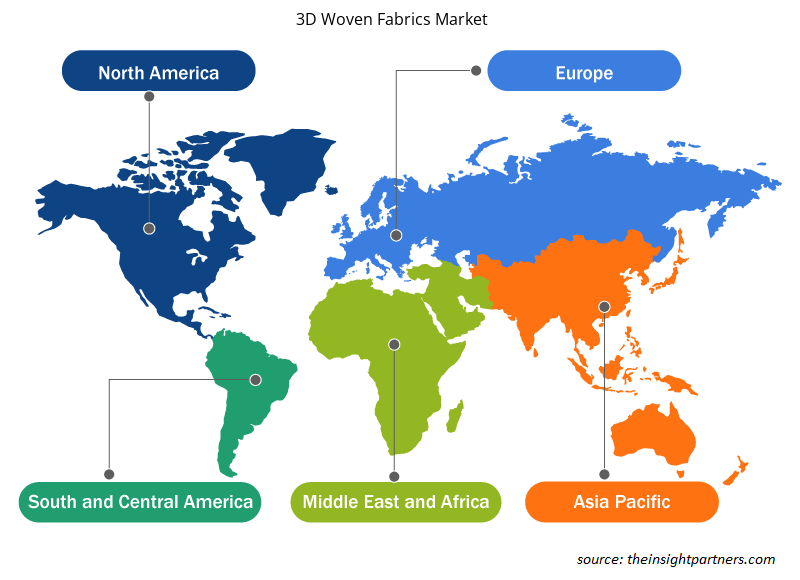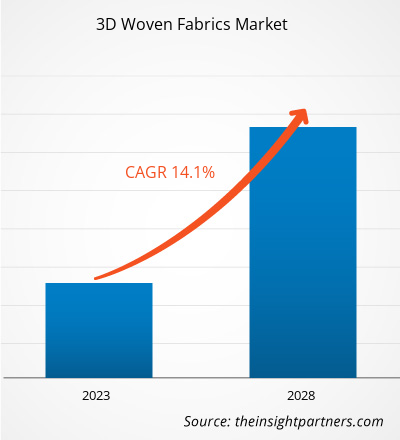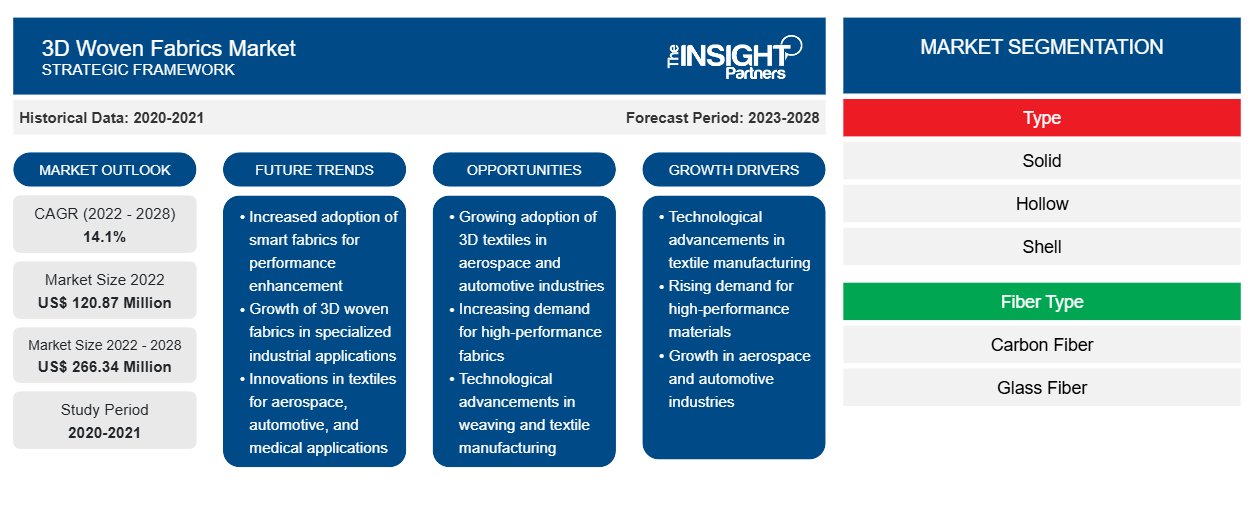[Rapporto di ricerca] Si prevede che il mercato dei tessuti intrecciati 3D crescerà da 120,87 milioni di dollari nel 2022 a 266,34 milioni di dollari entro il 2028; si stima che crescerà a un CAGR del 14,1% dal 2022 al 2028.
I tessuti 3D sono leggeri rispetto alla maggior parte dei legni e dei metalli. La proprietà di leggerezza dei tessuti 3D rende il loro utilizzo importante negli aerei e nelle automobili, dove un peso inferiore offre una migliore efficienza nei consumi. Oggigiorno, i progettisti di aerei sono molto preoccupati per il peso, poiché ridurre il peso di un velivolo riduce la quantità di carburante di cui ha bisogno e aumenta la velocità che può raggiungere. Inoltre, i tessuti 3D resistono ai danni causati dalle intemperie e dalle sostanze chimiche aggressive. Possono essere modellati in forme complicate più facilmente rispetto alla maggior parte degli altri materiali.
Nel 2022, l'Europa ha detenuto la quota di fatturato del mercato dei tessuti 3D più grande del mercato globale dei tessuti 3D. La domanda di tessuti 3D in Europa è in aumento a causa dell'aumento delle attività di ricerca e sviluppo rispetto all'utilizzo di tessuti 3D in settori di utilizzo finale come aeromobili, automotive, edilizia e costruzioni e molti altri. I tessuti 3D in Europa hanno il potenziale per creare opportunità di business, esportazione e applicazioni di produzione avanzate per i settori aerospaziale e automobilistico nella regione. Ciò ha portato a un rapido aumento della popolarità dei tessuti 3D in Europa. Secondo la Commissione europea, l'Unione europea ha investito circa 103 miliardi di dollari nel programma di finanziamento per la ricerca e l'innovazione, Horizon 2021, dal 2021 al 2027. Ha comportato finanziamenti per lo sviluppo di tessuti avanzati utilizzati nei settori dei trasporti e dell'aeronautica. Tutti questi fattori contribuiscono positivamente alla crescita del mercato dei tessuti 3D nella regione.
Personalizza questo report in base alle tue esigenze
Riceverai la personalizzazione gratuita di qualsiasi report, comprese parti di questo report, o analisi a livello nazionale, pacchetto dati Excel, oltre a usufruire di grandi offerte e sconti per start-up e università
-
Scopri le principali tendenze di mercato in questo rapporto.Questo campione GRATUITO includerà analisi di dati che spaziano dalle tendenze di mercato alle stime e alle previsioni.
Impatto della pandemia di COVID-19 sul mercato dei tessuti 3D
Settori come l'automotive, l'aerospaziale, l'edilizia e le costruzioni, la difesa e l'esercito hanno contribuito in modo significativo alla domanda di tessuti 3D. Nel 2020, questi settori hanno dovuto rallentare le loro attività a causa delle interruzioni nella catena del valore causate dalla chiusura dei confini nazionali e internazionali. La carenza di manodopera ha comportato la decelerazione delle operazioni di produzione e distribuzione di tessuti 3D. Le interruzioni nella catena di fornitura globale e la chiusura degli impianti di produzione di resina hanno portato a un forte aumento dei prezzi dei tessuti 3D. I blocchi imposti da diversi paesi nel 2020 hanno ostacolato la capacità dei settori di mantenere i livelli di inventario. Inoltre, le misure sanitarie e altre precauzioni COVID-19 hanno ridotto significativamente la capacità produttiva, creando una carenza di inventario di tessuti 3D. Tuttavia, nel 2021, il mercato globale ha iniziato a riprendersi dalle perdite subite nel 2020, poiché i governi di diversi paesi hanno annunciato un allentamento delle restrizioni sociali. Inoltre, l'aumento dei tassi di vaccinazione ha contribuito a migliorare le condizioni generali in diversi paesi, il che ha portato ad ambienti favorevoli al progresso industriale e commerciale. Inoltre, le crescenti capacità produttive nell'industria automobilistica e in altri settori in Europa e Nord America hanno portato a un aumento della domanda di tessuti 3D nel 2021.
Approfondimenti di mercato
Crescente domanda di tessuti 3D nel settore automobilistico e aeronautico
I materiali avanzati sono essenziali per aumentare il risparmio di carburante delle automobili moderne, garantendo al contempo sicurezza e prestazioni. La sostituzione di componenti in ghisa e acciaio tradizionale con materiali leggeri come i tessuti 3D ad alta resistenza riduce il peso della carrozzeria e del telaio di un veicolo, riducendo così il consumo di carburante di un veicolo. Inoltre, i tessuti 3D sono adatti per la produzione di componenti interni non strutturali, schienali dei sedili, rivestimenti del padiglione, pannelli interni e cruscotti. L'utilizzo di compositi rinforzati con fibre naturali sta aumentando nelle applicazioni aeronautiche a causa di leggi e regolamenti che costringono i produttori a utilizzare materiali sostenibili e riciclati per produrre veicoli leggeri ed efficienti in termini di carburante. Inoltre, i produttori di aeromobili stanno compiendo sforzi per ingrandire le strutture termoplastiche primarie nei jet aziendali e negli aerei commerciali. Sono stati i primi ad adottare termoplastiche rinforzate con fibre lunghe.
Tipo Informazioni
In base al tipo, il mercato globale dei tessuti 3D è segmentato in solido, cavo, a guscio e nodale. La quota di mercato globale dei tessuti 3D per il segmento solido è stata la più grande nel 2022. Il solido 3D si riferisce ad architetture intrecciate con sezioni trasversali solide in un pannello largo o in una preforma a forma di rete. È una struttura che comprende sezioni integrate a più pareti nelle direzioni della larghezza e dello spessore del tessuto, definendo una forma trasversale senza alcuna apertura a tunnel nella direzione della lunghezza del tessuto. Il solido 3D è costituito da interblocchi multistrato, ortogonali e angolari. L'ortogonale si basa su filati dritti. I filati di ordito e trama vengono utilizzati per gestire lo spessore del tessuto. Questa struttura ha una frazione di volume maggiore rispetto ad altre. L'interblocco angolare si basa su strati individuali. Ogni strato è diverso dall'altro. Le strutture solide 3D vanno da due a quattro strati. Si prevede che il segmento solido crescerà in modo significativo e rappresenterà la crescita delle dimensioni del mercato dei tessuti 3D.
I principali attori che operano nel mercato globale dei tessuti 3D includono Textum OPCO LLC, Tex Tech Industries Inc, Sigmatex (UK) Ltd, 3D Woven SaRL, Tantra Composite Technologies Pvt Ltd, U-Long High Tech Textile Co Ltd, TEAM Inc, Changzhou Bolong Three Dimensional Composites Co Ltd, Topweaving New Material Tech Co Ltd e China Beihai Fiberglass Co Ltd. Gli attori che operano nel mercato globale dei tessuti 3D si concentrano sulla fornitura di prodotti di alta qualità per soddisfare la domanda dei clienti. Si stanno inoltre concentrando su strategie quali investimenti in attività di ricerca e sviluppo e lanci di nuovi prodotti.
Approfondimenti regionali sul mercato dei tessuti 3D
Le tendenze regionali e i fattori che influenzano il mercato dei tessuti 3D durante il periodo di previsione sono stati ampiamente spiegati dagli analisti di Insight Partners. Questa sezione discute anche i segmenti e la geografia del mercato dei tessuti 3D in Nord America, Europa, Asia Pacifico, Medio Oriente e Africa e America meridionale e centrale.

- Ottieni i dati specifici regionali per il mercato dei tessuti 3D
Ambito del rapporto di mercato sui tessuti 3D
| Attributo del report | Dettagli |
|---|---|
| Dimensioni del mercato nel 2022 | 120,87 milioni di dollari USA |
| Dimensioni del mercato entro il 2028 | 266,34 milioni di dollari USA |
| CAGR globale (2022 - 2028) | 14,1% |
| Dati storici | 2020-2021 |
| Periodo di previsione | 2023-2028 |
| Segmenti coperti |
Per tipo
|
| Regioni e Paesi coperti |
America del Nord
|
| Leader di mercato e profili aziendali chiave |
|
Densità dei player del mercato dei tessuti 3D: comprendere il suo impatto sulle dinamiche aziendali
Il mercato dei tessuti 3D sta crescendo rapidamente, spinto dalla crescente domanda degli utenti finali dovuta a fattori quali l'evoluzione delle preferenze dei consumatori, i progressi tecnologici e una maggiore consapevolezza dei vantaggi del prodotto. Con l'aumento della domanda, le aziende stanno ampliando le loro offerte, innovando per soddisfare le esigenze dei consumatori e capitalizzando sulle tendenze emergenti, il che alimenta ulteriormente la crescita del mercato.
La densità degli operatori di mercato si riferisce alla distribuzione di aziende o società che operano in un particolare mercato o settore. Indica quanti concorrenti (operatori di mercato) sono presenti in un dato spazio di mercato in relazione alle sue dimensioni o al valore di mercato totale.
Le principali aziende che operano nel mercato dei tessuti 3D sono:
- Testo OPCO LLC
- Tex Tech Industries Inc
- Sigmatex (Regno Unito) Ltd
- Tessitura 3D SaRL
- Tecnologie composite Tantra Pvt Ltd
Disclaimer : le aziende elencate sopra non sono classificate secondo un ordine particolare.

- Ottieni una panoramica dei principali attori del mercato dei tessuti 3D
Segnala i riflettori
- Tendenze industriali progressive nel mercato dei tessuti 3D per aiutare gli operatori a sviluppare strategie efficaci a lungo termine
- Strategie di crescita aziendale adottate dai mercati sviluppati e in via di sviluppo
- Analisi quantitativa del mercato dei tessuti 3D dal 2020 al 2028
- Stima della domanda globale di tessuti 3D
- Analisi delle cinque forze di Porter per illustrare l'efficacia degli acquirenti e dei fornitori che operano nel settore
- Sviluppi recenti per comprendere lo scenario competitivo del mercato
- Tendenze e prospettive di mercato, nonché fattori che guidano e frenano la crescita del mercato dei tessuti 3D
- Assistenza nel processo decisionale evidenziando le strategie di mercato che sostengono l'interesse commerciale, portando alla crescita del mercato
- Le dimensioni del mercato dei tessuti 3D in vari nodi
- Panoramica dettagliata e segmentazione del mercato, nonché dinamiche del settore dei tessuti 3D
- Le dimensioni del mercato dei tessuti 3D in varie regioni con promettenti opportunità di crescita
Mercato globale dei tessuti 3D
In base al tipo, il mercato dei tessuti 3D è segmentato in solido, cavo, a guscio e nodale. In base al tipo di fibra, il mercato globale dei tessuti 3D è segmentato in fibra di carbonio , fibra di vetro e altre. In base all'applicazione, il mercato dei tessuti 3D è segmentato in balistica, aeromobili, trasporti, edilizia e costruzioni e altre.
Profili aziendali
- Testo OPCO LLC
- Tex Tech Industries Inc
- Sigmatex (Regno Unito) Ltd
- Tessitura 3D SaRL
- Tecnologie composite Tantra Pvt Ltd
- Azienda tessile ad alta tecnologia U-Long Co. Ltd.
- SQUADRA Inc.
- Changzhou Bolong Compositi tridimensionali Co Ltd
- Tessitura superiore Nuovo materiale Tech Co Ltd
- Cina Beihai Fiberglass Co Ltd
- Analisi storica (2 anni), anno base, previsione (7 anni) con CAGR
- Analisi PEST e SWOT
- Valore/volume delle dimensioni del mercato - Globale, Regionale, Nazionale
- Industria e panorama competitivo
- Set di dati Excel
Report recenti
Rapporti correlati
Testimonianze
Motivo dell'acquisto
- Processo decisionale informato
- Comprensione delle dinamiche di mercato
- Analisi competitiva
- Analisi dei clienti
- Previsioni di mercato
- Mitigazione del rischio
- Pianificazione strategica
- Giustificazione degli investimenti
- Identificazione dei mercati emergenti
- Miglioramento delle strategie di marketing
- Aumento dell'efficienza operativa
- Allineamento alle tendenze normative























 Ottieni un campione gratuito per - Mercato dei tessuti 3D
Ottieni un campione gratuito per - Mercato dei tessuti 3D